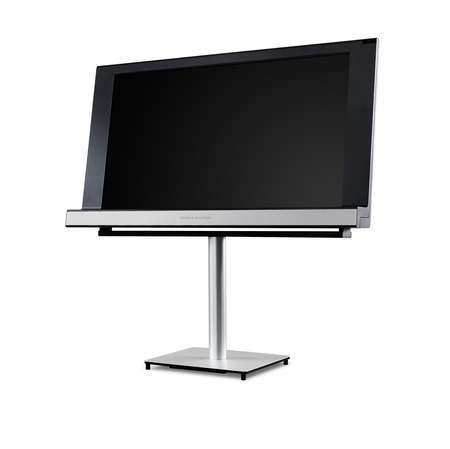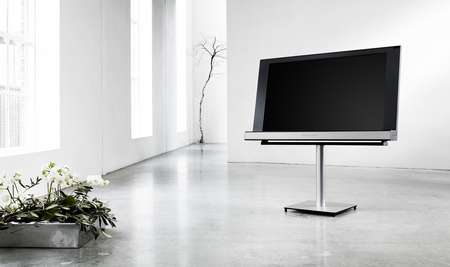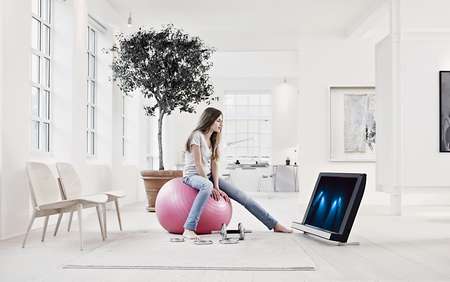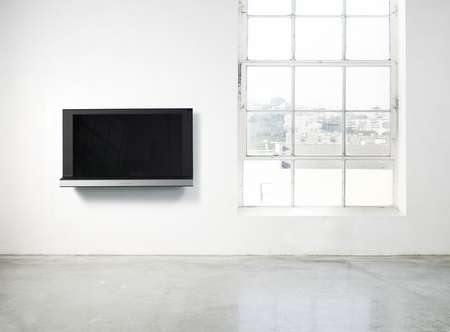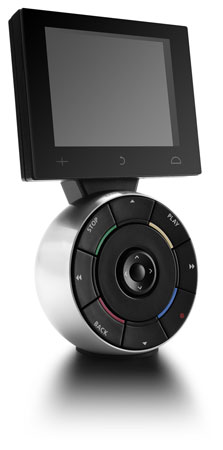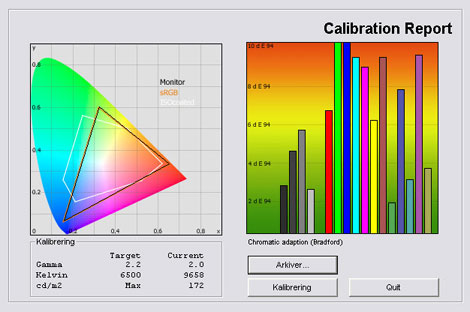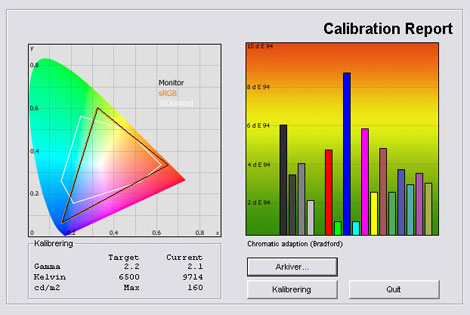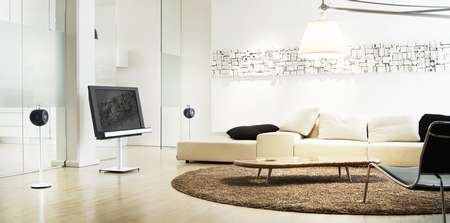Review: Bang & Olufsen BeoVision 8-40
Introduction
Back in 2007, Bang & Olufsen launched their first 26-inch BeoVision 8 model, BeoVision 8-26, followed thereafter by the 32-inch BeoVision 8-32. However, to satisfy demand for a 40-inch version of the model, Bang & Olufsen have now launched BeoVision 8-40.
Both the 26-inch and 32-inch were a little too late and the market already moved past these sized. Now the 40-inch model has finally caught giving consumers what they need for the living room.
The BeoVision 8 range combines the timeless David Lewis design with the famous Bang & Olufsen dedication to picture and sound quality. Last but not least, it’s made all the more attractive for the consumer with its eye-catching design, featuring a prominent loudspeaker under the screen.
FlatpanelsHD has received BeoVision 8 to find out just what the high-end Danish manufacturer has come up with for the discerning consumer looking for a Bang & Olufsen flat screen at around 4.000 Euro.
Please note that the 40-inch version differs from the smaller ones. The panel, inputs and sound systems are a little different.
The test will also be followed up with our review of the giant 103” BeoVision 4-103, as well as a review of the new B&O BeoVision 10, and BeoVision 7-55. Subscribe to our newsletter to receive e-mails when these reviews are online.
Panel size: 40" widescreen (LCD) Resolution: 1920x1080 Response time: - Contrast ratio: 80000:1 (dynamic) Brightness: - Colour support: 16,7 millions Signal processing: 8 bit for each colour Viewing angles (H/V): 178/178 Dot pitch: - Panel type: LCD (Samsung/Sony) Wall mounting: Swivel stand: Dimensions(HxWxD): 63 cm x 106 cm x 26 cm (with stand) Weight 26 kg Built-in speakers: Input formats: 480p/i, 576p/i, 720p, 1080i & 1080p (50, 60 & 24p) 1:1 pixel mapping: Inputs • VGA • DVI (can be converted through HDMI)
• Audio (type) (Audio in/out)
• SCART (2 inputs)
• S-video • Composite • Component 
• HDMI (2 inputs)
• Andet Outputs • Audio (type) (1 output)
• SCART • S/PDIF (optical)
Tuners • Analogue • DVB-T • DVB-T (MPEG4) • DVB-C • DVB-C (MPEG4) • DVB-S • DVB-S (MPEG4) Our first impressions
With its dramatic design and function, BeoVision 8-40 is unmistakable. Bang & Olufsen have never compromised in terms of sound quality, and this new BeoVision 8 model is no exception.
Some have called the bottom speaker merely a dust collector and somewhere to store the remote control, but for me, the slightly atypical design has grown on me. The more you look at BeoVision 8-40, the more you love it.
The finish is as you’d expect from Bang & Olufsen: the material feels luxurious and the joins are knife sharp. It’s not aluminium and really high-end materials like on the more expensive B&O TV’s but BeoVision 8-40 features a nice mix of mid to semihigh-end quality materials.
The black matte frame surrounds the panel and rounds off at the bottom speaker, which has a grey front with the Bang & Olufsen logo positioned in the middle.
You can position BeoVision 8-40 either on a stand or simply place it on a hi-fi table using the supplied feet.
The inputs are conveniently positioned facing downward at the rear of the TV. Connectivity includes 2 HDMI inputs, which, if you have as much equipment as I have, is somewhat limiting.Test tools
Our TV signal is DVB-S (satellite) from Canal Digital and DVB-T (terrestrial). We also have an analogue TV connection.
Testing is done with the DVE (digital video essentials) and Peter Finzel test DVD. Testing is also done with DVD, TV, Blu-Ray and Mediacenter/PC.
We also use our own monitorTest . The software supports some of the traditional test patterns used to evaluate displays as well as some new and unique test patterns developed by the people here on Flatpanels.
Sony PlayStation 3 is our Blu-Ray player.Functionality
There are numerous ways to remotely-control Bang & Olufsen products, but for the purposes of this test we will be using the Beo4 remote (image shown). Another option would be Beo5.
The Beo4 remote is different from most other remote controls. It is build from high-end materials with a solid black metal frame and a silver metal surface. The remote is very solid and demonstrates quality just with its prominent appearance.
Beo4 a display at the top which shows your choices but besides that doesn’t have any extra functionality. The remote feels good in our hand. Another choice for the B&O televisions is the Beo5
The Bang & Olufsen's menus are simple enough, but if you’re used to using other TV navigation menus, this one takes a little getting used to. In terms of picture settings, you’re limited to brightness, contrast and colour.Power consumption
The consumption figures for BeoVision 8-40 are as follows:
| Out-of-Box | After calibration | |
| Stand-by | 0,0 W | 0,0 W |
| SD | 180 W | 173 W |
| HD | 180 W | 173 W |
Also, please note that the flat panel TV uses less power after calibration. This is common on flat panel displays because many picture parameters are reduced during calibration.
Picture quality
After turning on BeoVision 8, you’re greeted by a theatrical opening-curtain display, which reveals the picture gradually from the middle. Over the years, this feature has become something of a Bang & Olufsen hallmark.I took the following preliminary measurement of the BeoVision 8-40 picture quality:
The graph says this:
The number on the left is the delta value. Delta is a difference between two factors; here it’s the difference between the measured colour on the panel and the actual colour that is our target.
This Bang & Olufsen has a very high colour temperature of over 10,000 Kelvin (for pure white), which in practical terms gives the screen more of a blue and"cold" picture than that given by our target temperature of 6,500 Kelvin. This isn’t unexpected for an LCD TV, but Bang & Olufsen TVs tend to be a little lower than what we are seeing with this example.
It’s mostly the brightest colours/white that has the high colour temperature. For most other colours B&O aims for 8500 Kelvin (the graph above shows the highest value of colour temperature measured).
Some consumers prefer their picture this way (colder with a blue tint). Perhaps Bang & Olufsen are catering for these consumers with BeoVision 8-40, but we still prefer the slightly more red and warm picture given with a 6500 K temperature – today’s standard in picture quality.
The standard colour settings are not too precise, due partly to the imprecise gamma and partly to the colour temperature. Gamma, the balance of light from dark to light colours, is consistently a little too low. On our test TV, this resulted in the colours being slightly too light and intense (not much but slightly).
Bang & Olufsen offers a fairly limited number of ways to adjust picture settings in the menu, but I did my best with what was available. The result is as follows:
I wasn’t able to lower the colour temperature, but I was able to improve the gamma. This resulted in slightly better colour reproduction, but still a colder picture with a slight oversaturation of blue.
The figures after calibration:
| After calibration | |
| Lys: | -2 |
| Contrast | -7 til -9 |
| Colour: | 0 |
| Size: | 0 |
Note in the above table that 0 means that I let the settings remain in the middle (Bang & Olufsen doesn't use numbers in its menus). The brightness value of -2 means that I moved the level two settings to the left. I lowered the setting called “light” in order to improve the gamma and therefore colour reproduction. I also reduced the contrast a little, to reduce the amount of light on the screen.
Despite this, I can’t contain my excitement about the experience delivered by the BeoVision 8; the picture quality is simply incredibly impressive and detailed. Despite the slightly high colour temperature, Bang & Olufsen have produced a fantastic picture circuit that delivers sharp, detailed and beautiful pictures (I will explain this in more detail later).
I asked Bang & Olufsen why they chose this colour temperature. They told me the slightly higher colour temperature was a deliberate move, and a direct outcome of the extensive user and blind testing carried out by the company. So they certainly listen to their consumers; I just miss the ability to choose 6500 Kelvin, for example when watching movies.
Standard TV signals are reproduced faithfully, and even the most compressed and sub-standard transmission is transformed into a reasonable picture on BeoVision 8. The experience is more or less the same when watching analogue signals, which many flat screens tend to have big problems with. However, it's clear that digital signals are more attractive and clearer. BeoVision 8-40 has an integrated DVB-T tuner with mpeg4, avoiding the need for an extra set-top box when the new digital TV signal starts on 1 November 2009.
HDTV is beautiful on BeoVision 8. The level of detail is high and colour reproduction subtle. The contrast glass on the LCD panel slightly echoes that of a plasma screen. The screen glass adds to the picture quality, though it does suffer from slight daylight reflections.
BeoVision 8-40 also has a 100 Hz system, although it differs from systems implemented by the other LCD TV manufacturers like Samsung and Sony.
We have never been particularly enthusiastic about Samsung's 100 Hz system, as it gives the picture a slightly artificial and unnatural look. Bang & Olufsen’s 100 Hz system, however, doesn’t suffer from this, as they have evolved the technology. In fact, the company has improved 100 Hz technology to such an extent that it has even patented its own version.
The Bang & Olufsen 100 Hz system constantly adjusts the level of smoothing and blur-reduction to match the content displayed on the screen. This means that grainy content is converted to 100 Hz in a different way than digital content, and high-contrast pictures are converted to 100 Hz in a different way than low-contrast pictures.
We got to see this first-hand, when we were given exclusive access to Bang & Olufsen’s flat screen development environment – Media Room. As we were to see, pictures react differently at 100 Hz. High-contrast pictures seem to judder without 100 Hz, while those with low contrast appear more blurry. 100 Hz technology therefore needs to take this into account.
So what does this mean in practice? It means the picture benefits; what you experience is a more fluid and smooth picture that avoids becoming unnatural to look at - something we often experience with Samsung LCD TVs. This is particularly beneficial when watching football, where the picture has a high level of fluidity and coherence.
However, even this technology has its limits, as very fast and grainy movie sequences can produce slight anomalies. For example, you can sometimes notice slight artifacting (“messy” pixels) around moving objects, although this happened only very rarely in a slightly grainy action scene from Band of Brothers. Less critical eyes than mine probably won’t even notice them at all.
All in all, in my opinion, the 100 Hz system is a welcome feature for BeoVision 8-40, simply because Bang & Olufsen have put their heart and soul into raising the bar for this technology.
The attractive picture quality on the Bang & Olufsen BeoVision 8-40 is a result of an extremely sophisticated picture circuit, which handles the task more than capably – better, in fact, than the majority of more expensive TVs.
The picture setup isn't yet 100 %, with slightly imprecise gamma and high colour temperature. Despite these factors, though, BeoVision 8-40 is still capable of delivering a highly-attractive picture, mainly due to the fine picture circuit controlling the TV.
The picture circuit technology has many of the scaling, de-interlacing and other circuit technologies that are also featured in other Tv sets, B&O’s picture circuits takes picture detailing and handling to a higher level, delivering very detailed still and moving pictures.
I also measured black reproduction:
| Out-of-Box | After calibration | |
| Black level | 0,11 cd/m2 | 0,09 cd/m2 |
| Brightness | 172 cd/m2 | 160 cd/m2 |
| Contrast ratio | 1563:1 | 1778:1 |
Contrast ratio +/- 50
Black reproduction is impressive with good depth. This is partly due to the way Bang & Olufsen have configured the LCD panel and partly down to the addition of the contrast glass mounted on the front of the panel.
Black reproduction after calibration using LaCie blue eye pro gave a figure of 0.09 cd/m2. This is not at the same level as, for example, Pioneer, but in any case is a very impressive and deep black level for an LCD TV that ensures dynamic and rich picture contrast – also during evening viewing.
Shadow detail (the ability to reproduce the darkest colours) is close to ideal. It see very nice shadow detailing in practice but also in our monitorTest software where BeoVision 8-40 is able to produce most of the shadow detail steps.
I have also looked for signs of what's commonly referred to as clouding or backlight bleeding. This is a phenomenon that can occur on LCD panels, as they can have a tendency to bleed more light out to the corners or edges of the LCD panel. This is most apparent during the evening when it's dark outside. I can report that BeoVision 8-40 doesn’t suffer at all from this, which is good. Below you can see an image of the screen when switched on in a pitch-black room:
BeoVision 8-40 has no problems with clouding.
PC and media center
There were no problems connecting BeoVision 8-40 to a PC or media center. I used one of the HDMI inputs at the rear.Viewing angles
Viewing angles with this TV are among the best for an LCD TV, though not perfect. The TV inclines slightly back as standard, but this doesn’t affect picture reproduction. The picture changes mainly when viewing from acute angles, where the TV loses a little contrast and colour intensity. However, I certainly wouldn’t take this as a criticism of BeoVision 8-40.
Sound
Sound quality has been a focal area for Bang & Olufsen for as long as it has existed. The company has never been one to compromise, releasing audio products such as the renowned BeoLab 5 active loudspeaker.Whatever people think about Bang & Olufsen, you can’t deny they have some of the best consumer audio systems, and have even achieved success in the car audio world with integration into most Audis and Aston Martins.
With the large loudspeaker positioned prominently below the screen, BeoVision 8-40 isn’t shy about its commitment to sound quality. The same design is also found on the 26" BeoVision 8-26 and 32” BeoVision 8-32, but with the BeoVision 8-40, there’s space for even more loudspeaker.
Bang & Olufsen explains that the loudspeaker in BeoVision 8-40 has been improved in a number of areas. First and foremost is the larger power supply. The voltage has also been increased to 17 V, which almost doubles the available power compared with the smaller models.
Even the construction of the loudspeaker system has been altered and now features genuine soft-dome tweeters. The smaller BeoVision 8 models feature 2 integrated full-range units and a single woofer.
In contrast, BeoVision 8-40 has a single woofer, 2 genuine mid-range (specially-optimised for mid-range use) and finally 2 soft-dome 3/4” tweeters.
Tommy Jakobsen, Head of Communication at Bang & Olufsen told us:
- “It clearly gives the picture more atmosphere and a relaxed clarity to the sound. This also means that we have five available amplifier channels, as the system is fully active. In contrast, the smaller models have three channels.”
He continues:
- “The large cabinet provides more space for the woofer. The port is balanced to the same frequency, but can have a slightly larger cross-section, which reduces unwanted sound produced by turbulent airflow.”
And the verdict? There’s no doubt that BeoVision 8-40 delivers incredible sound quality for a flat screen TV. There is no comparison with other flat screens, as Bang & Olufsen are far more dedicated to sound quality. The result is a sound picture that is subtle and precise, with deep and full bass reproduction contributing to the excellent sound.
All in all, sound quality is exceptional. No other flat screen I have tested comes close to BeoVision 8-40. Given the physical size of the loudspeaker, you could say that great sound would be a given, but Bang & Olufsen have produced a flat screen that performs equally well with both film and music.
Conclusion:
Bang & Olufsen calls BeoVision 8 its lower-price entry-level range. The 40” model is priced at around 4.000 Euro. For that price, you get the renowned Bang & Olufsen picture and sound quality you’d expect. We guarantee you won’t be disappointed.I have focused on picture and sound quality in this review of BeoVision 8-40, which means that I haven’t covered the many Bang & Olufsen link options. My experience with BeoVision 8-40 leaves me in no doubt that it is in a different class than other LCD TVs.
The picture quality is fantastic. Despite the fact that Bang & Olufsen aim for a slightly high colour temperature that makes the picture a little more blue and"cold" (and doesn't give precisely the right colour), the company's excellent picture circuit manages to take the picture quality to another level. The level of detail and handling of movement is unrivalled by other LCD manufacturers and BeoVision 8-40 demonstrates that LCD technology has a lot more potential than we're used to seeing with less-capable LCD flat screens.
And we shouldn't forget the sound quality, which is incredibly full and enjoyable. The large loudspeaker cabinet really raises the sound quality to new heights, making it perfectly suited to both good music and movies. Compared to other flat screens, the sound from BeoVision 8-40 is in a class of its own.
BeoVision 8-40 is lacking in only a few areas. I would like one or two more HDMI inputs, and the colour temperature could be a little lower (including the ability to choose 6500 K).
All in all, BeoVision 8-40 is an incredibly well thought out TV. The price will probably put some consumers off, but Bang & Olufsen aficionados won't be disappointed by either the picture or sound quality of BeoVision 8-40. This is a fantastic TV – and furniture.
We therefore give Bang & Olufsen 8-40 a Recommendation Award.
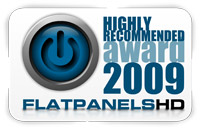
Press the award logo to learn more.
The test will also be followed up with our review of the giant 103” BeoVision 4-103, as well as a review of the new B&O BeoVision 10, and BeoVision 7-55. Subscribe to our newsletter to receive e-mails when these reviews are online.
| Pros | Cons | Target group |
| Impressive picture quality | Too high colour temperature | Living room |
| Amazing sound | Only 2 HDMI | Home cinema |
| Deep blacks and contrast | ||
| 100 Hz system |
---
For questions and comments please visits this thread in our forums: http://www.flatpanelshd.com/flatforums/viewtopic.php?f=5&t=428



